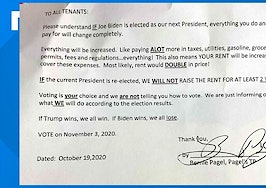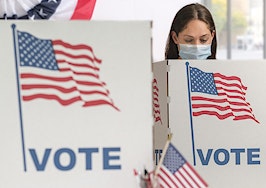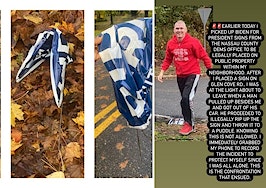After a bruising campaign year that seemed to upend precedent by the hour, voters finally headed to the polls Tuesday to decide if the U.S. ought to stick with the norm-busting political chaos theory of Donald Trump, or gamble on a change of guard with Joe Biden.
Election Day arrived after the two candidates poured more than $1 billion into key battle ground states alone, and as people across the political spectrum argued that this year represents an existential moment for the American way of life. But as in-person voting actually began Tuesday, perhaps the most significant development was a consensus that — unlike most elections in recent memory — the outcome could actually take days or longer to pin down.

Trump and Biden at the final presidential debate at Belmont University on Oct. 22, in Nashville, Tennessee. Credit: Chip Somodevilla and Getty Images
The most obvious reason for the uncertainty is the coronavirus pandemic, which in addition to ravaging the economy for most of 2020 has also forced widespread social distancing mandates. The result: Nearly 100 million Americans voted early before Election Day even arrived. In California alone, more than 11 million people voted early, and Texas and Florida weren’t far behind with nearly 10 million and nearly 9 million early votes, respectively.
The pandemic has grown increasingly politicized and on the eve of Election Day. Trump — who in October had COVID-19 — indicated he may actually fire infectious disease expert Dr. Anthony Fauci.
But the pandemic wasn’t the only wildcard Tuesday. The lion’s share of the early votes were cast via mail, a concept that Trump himself has spent months assailing as unreliable. Experts have generally rejected Trump’s complaints about remote voting, but the president’s criticisms nevertheless raised numerous questions about which votes would ultimately be counted, and when.
And indeed on Monday, the Trump campaign was already fighting a legal battle to stop officials from counting ballots mailed from Nevada’s left-leaning Clark County. Two days before the election, the Trump campaign also promised a legal fight over absentee ballots in Pennsylvania.

Trump speaks during a campaign rally on Nov. 2 in Traverse City, Michigan. Credit: Rey Del Rio Getty Images
Many observers expect such fights to only intensify as the polls close Tuesday, plunging the country into a national debate over ballot legitimacy unlike any that has happened before. And assuming no landslide forms Tuesday, that debate could potentially rage for days or weeks.
Still, despite the flood of mail-in ballots, many more Americans headed to the polls in person beginning Tuesday morning. Ellen Sykes watched them come. Sykes is a broker in Manhattan with Warburg Realty, and on Tuesday she was also a volunteer poll worker whose job was to stand outside and direct people to the ballot box.

Ellen Sykes
Sykes told Inman Tuesday morning that there was a “flurry” of voters right at 6 a.m. when the polls opened. But in the ensuing hours it had been “really quiet” and most voters were able to get in and out quickly without even having to wait in line. She added that her daughter, who was volunteering in a different New York City location, reported similar conditions.
“I think the early voting really made a huge difference,” she said late Tuesday morning.
In Sykes’ case, those quiet conditions were fortuitous, allowing her to actually make an offer on a client’s behalf while working the lines.
“I put in an offer about an hour ago,” she said during her call with Inman.
Hours later, Sykes once again spoke to Inman and revealed that not much had changed over the course of the day.
“It’s gotten quieter and quieter and quieter,” she said. “We haven’t had a voter in a half an hour.”
Sykes remained convinced late Tuesday that early voting was behind the relative calm at her polling place.

People stand in line to vote as the sun rises at the Main Street Branch Library vote center on Nov. 3 in Huntington Beach, California. Credit: Apu Gomes and Getty Images
However, not every polling place was quite so sleepy Tuesday morning. The New York Times reported, for instance, that in Philadelphia long lines snaked all the way around voting locations. Images from the scene showed many people spaced six feet apart in an effort to avoid spreading COVID-19.
In Atlanta, dozens of voters lined up to vote more than a hour before their polling place even opened, the Associated Press reported. Long lines were also reported in, among other places, South Carolina, Missouri, California and Mississippi. In the latter state, some voters showed up at 5 a.m. and ultimately waited two hours to cast their ballots, WAPT reported.
By Tuesday evening, other states were reporting that they had seen extraordinary engagement levels. For example, Maine Secretary of State Matthew Dunlap told CNN that his state could break records and that “turnout was pretty strong and steady in most places we’ve gone.” And in Michigan, more than 18,000 new voters registered on Tuesday, according to CNN.
Long lines are not ultimately unusual during national elections, but there were more ominous signs as well Tuesday. Sykes told Inman that she had seen businesses along Manhattan’s Fifth Avenue boarded up, apparently in anticipation of potential unrest.

A person walks by a boarded up Saks Fifth Avenue on Nov. 1 in New York City. Credit: David Dee Delgado and Getty Images
Sykes added that she does not expect violence on the streets in her city.
Nevertheless, numerous reports of businesses boarding up their windows in order to withstand violence, vandalism and looting trickled in from New York, Washington, D.C., Los Angeles, Chicago, Salt Lake City and many other metro areas around the U.S.

Buildings are boarded up in anticipation of Election Day vandalism in Washington, D.C. on Nov. 2. Credit: Chip Somodevilla and Getty Images
The fear of violence on Election Day also followed increasingly tense incidents in the final days of the campaigns. Among other things, those incidents have included so-called “Trump trains” — or processions of vehicles driven by Trump supporters — snarling traffic and in one case surrounding a Biden campaign bus. That latter incident caused a collision, prompted an FBI investigation and led to the cancelation of several pro-Biden events.
The fact that Trump expressed approval for the bus incident, and has repeatedly called on his supporters to watch polls for signs of fraud, only heightened concerns that Election Day could ultimately devolve into street clashes between political opponents.
Concerns about voter interference were so intense that, according to The Atlantic, the Biden campaign gamed out potential scenarios in which Trump could attempt a coup. And in a testament to the level of anxiety on the left, that story and another speculative piece about a Trump coup were both among the most popular articles on The Atlantic‘s website Tuesday.

Voters wait in line to cast their ballots on the final day of early voting for the 2020 presidential election on Nov. 2, 2020 in Cedar Rapids, Iowa. Credit: Mario Tama and Getty Images
The point is that by early Tuesday, America was like a rubber band stretched nearly to its snapping point. However, despite the tension, by Tuesday evening the AP reported that there had been relatively few hiccups during the day across the country — hinting that for all the acrimony of the campaign season the U.S. might still pull off a relatively straightforward election.
It was no surprise, then, that in the days before the election a Redfin survey revealed that 16 percent of Americans would consider leaving the country if their preferred candidate were to lose. That number represents a startling jump from 2016, when only 9 percent of Americans indicated a willingness to expatriate due to election results.
Those results hint at the idea that while voters on both sides seemed to envision the election as a struggle between good and evil, they also apparently believed the results could have very real impacts on their day-to-day lives. For example, another Redfin survey — conducted in October and based on more than 3,000 responses — found that 42 percent of Americans saw Trump as better for homeowners, compared to just 38 percent who said the same thing about Biden.
On the other hand, 42 percent of respondents expected Biden to be better for renters, verses 35 percent who thought the same of Trump.
Additionally, a group of landlords sent out letters to tenants in October stating that if Biden were to prevail “everything you do and have to pay for will completely change.” The letters ultimately promised rent increases under a Biden presidency, but not under four more years of Trump.
Given the stakes for the housing industry, it’s no surprise that members of the real estate industry were actively engaged in the election this season. Among them, Chavi Holm, a member of Team Diva Real Estate in Seattle, told Inman she and her team started planning their election involvement all the way back in 2019.

Chavi Holm, left, and Team Diva managing broker Kim Colaprete distributing campaign materials. Credit: Chavi Holm
“We decided to do 60 days of activism, leading into the election cycle,” she explained. “In December 2019, we came up with a fairly comprehensive plan to not only join in with our cohort but to be leaders in this. On Sept. 3, we did a massive rollout of 60 days of activism.”
That activism involved sending out postcards on how to create a voting plan to everyone in the team’s database. They also hosted politicians and activists on a weekly Facebook video show, and Holm turned her garage into a “socially distant campaign headquarters.”
“Friday nights and Sundays we basically wrote 600 postcards,” she said. “It’s not even about the move to vote, it’s the move to be an active participant in democracy.”
Lindsay Dreyer — CEO of City Chic Real Estate in the Washington, D.C., area — also worked to get out the vote. She told Inman that her team wanted to “walk the fine line of being annoying and helpful” and as a result settled on doing two campaigns during this year’s election season. The first campaign involved adding voter registration resources to the team’s newsletter.
“We had almost 200 people click to check their registration status!” she said.
The second campaign involved sending postcards to people in the team’s database. The postcards included information on where, when and how people can vote.
Though it’s difficult to know how exactly these various efforts impacted the election, it is at least worth noting that experts widely anticipated record-setting turnout this year. And if nothing else, the people who spoke with Inman see that level of engagement as a good thing.
“I’m just a great believer in democracy,” Sykes, the agent in Manhattan, said while she was working the voting lines. “And I think we haven’t seen as much as we need.”
Update: This post was updated after publication with additional information and quotes about Election Day.






